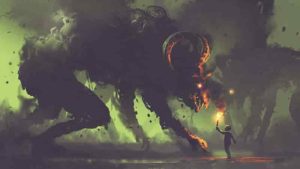In Dungeons and Dragons 5e, mystery campaigns challenge players to piece clues together to resolve a story plot. These adventures contain investigations (both the skill check and more generally) and interactions with complex NPCs. Naturally, these campaigns rely less on combat and more on puzzles, note-taking, social interactions and creative problem solving.
When creating a mystery campaign for DnD 5e, consider the following elements:
- Vary investigations with Charisma, Wisdom and Intelligence rolls.
- Use puzzles to unlock secrets, rooms and clues.
- Treat clues like treasure.
- Murder mysteries—vary NPC personalities.
- Ghost stories—resolve the haunting.
- Castle Intrigue—espionage in fancy clothes.
Vary investigations with Charisma, Wisdom and Intelligence rolls.
Firstly, we should break down investigations into more pieces than merely an Intelligence (Investigation) roll. If we simply rolled a d20 to solve the mystery, it wouldn’t be much of a campaign or adventure. Therefore, let’s take a look at other types of investigation rolls we can make throughout the mystery.
Intelligence
Intelligence checks are the most obvious for the purpose of investigating an environment.
- Investigation: Best reserved when nothing else makes sense. Room searches, hints to puzzles or riddles or piecing clues together that stump the players.
- Arcana: Anything involving the magic arts, planes of existence, symbols, magic items and arcane lore. This can be useful to find cursed items, recognize fiends and spirits or uncover a magical murder weapon.
- History: The lore of a particular region, the history behind a haunting and items with cultural significance can come in handy for a mystery.
- Religion: This covers knowledge of the gods, cults and rituals. Perhaps a murderer sacrificed for a dark entity or a cult is operating in secret. Religious symbols and behaviors can trigger this type of investigative roll.
- Nature: Aspects of nature can be out of place in strange situations. Maybe a strange mushroom is infecting a councilman’s chamber, revealing a secret buried beneath the floorboards. Or maybe the local farm animals are behaving strangely, signaling an eerie phenomenon.
Wisdom
Wisdom checks relate to experience, intuition and situational awareness. Fortunately, a wise character can intuit whether people are lying or perceive a clue the rest of the party misses.
- Perception: Revolving around the five senses, Perception rolls can offer players opportunities to find hidden clues or threats.
- Insight: Though Insight is most often used to read intentions of NPCs, we can also use Insight for hints to riddles or puzzles. Perhaps, we could even offer an Insight check to find a motive behind a murder.
- Survival: Lean into a ranger or druid character to discover tracks, traps or other signs of danger.
- Medicine: Mostly, find out whether a victim is diseased or poisoned.
Charisma
Especially with traditional mysteries, interacting with NPCs is going to be a part of the game. Even haunted house settings can have social encounters with spirits. Plus, players can lean on a general Charisma check to find the best person to talk to or get the general sense of a crowd.
Related Posts:
Guide to Building a Horror Campaign: DnD 5e/RPGs
| Guide to Building Puzzles in Your Campaign: DnD 5e
|
- Persuasion: Convince an agitated character to give away important info or change their mind about the party.
- Intimidation: Intimidate criminal characters who may know more information than they’re giving away.
- Deception: Convince a suspicious character that they aren’t under suspicion and catch them in a lie. Kind of like the detective Columbo.
Use puzzles to unlock secrets, rooms and clues.
When you think about it, mysteries are puzzles. We only get so much information—some of which we have to actively seek out. Then, we must put the clues together Scooby-Doo style to figure out the answer to the problem: the murderer, the source of the curse, the location of the relic, etc.
Therefore, it only makes sense to place other puzzles inside the mystery. The players are already in a headspace for critical thinking, and puzzles can vary the adventure from typical combat encounters and environmental hazards. Plus, I can reserve the best clues as a reward for solving the puzzle.
Tasha’s Cauldron of Everything introduces a fantastic collection of puzzles to try—ranging from easy to difficult. One of my favorite puzzles from this book is a quick, easy Creature Painting puzzle.
In the Creature Painting, we see different monsters in varying numbers. Through clues and hints, the party will discover a connection between the number of creatures and the letter they must pull from the creature’s name. If the painting contains 2 zombies, we pull the letter “o” from the word zombie. The trick is to create a password using this cypher.
Now, the party can find a lever to open a hidden chamber, find an important note inside a magic safe or even find the answer to a riddle.
Treat clues like treasure.
With the goal of solving an important problem, objects that piece the mystery together become some of the most valuable treasures to find. Therefore, we should make the party work for these clues as we would a valuable treasure.
Consider adding dungeon crawls and traditional adventure elements to gain important clues. For example:
- A caravan has been recently raided by goblins. Find the goblin camp a retrieve a journal from one of the stolen carriages.
- The old, haunted mansion has several basements the party must venture through to find the scene of long-forgotten crime. Now, the vengeful spirit’s killer can be outed, releasing the angry ghost to the afterlife.
- An escaped convict has made refuge in the vast sewers of a super city, and the party is hired to track this person down. However, finding this so-called criminal may reveal a twist in the story.
- The party wakes up in the barracks of an abandoned castle in another dimension. Now, the party must figure out where they are, why they’re at this place and how to get home. The party may find mysterious answers that lead to a bigger adventure.
Related Posts:
Monster of the Week RPG Review
| Guide to Building Pirate Characters: DnD 5e
|
Murder mysteries—vary NPC personalities.
Murder mysteries in DnD 5e can be tricky to pull off. However, subtle and interesting NPCs can make the mystery. Obviously, we can’t make the killer act suspiciously—we need to find a way to hide the crime amongst the personalities. Eventually, the clues should lead to the killer, so we can have fun with these characters.
A good trick to follow is to plant 2 or 3 misleading characters with potential motive. Agatha Christie gave us a whole train full of people with motive in Murder on the Orient Express—it’s a critical tool in mystery writing. Make the investigators second-guess themselves, and most of the work is done.
Try a few of these personalities:
- A wealthy, pretentious countess with fine tastes and financial motives to hire a killer.
- Criminals and thugs who are a little too believable as the killer.
- A Scrooge-like old man who holds family honor above all else. Now, the deceased is a person who insulted his family.
- Sweet children who turn out to be changelings or other shapeshifting monsters.
- Characters who are mourning a separate loss.
Finally, drop real hints to the actual killer. Players will want to be brilliant and piece the mystery together like Sherlock Holmes. Therefore, constantly trying to outsmart and mislead them can get annoying.
Ghost stories—resolve the haunting.
Another popular mystery adventure is the ghost story—complete with personal drama, gothic environments and mysterious spirits.
For these adventures, the haunting can be the center focus of the mystery or an accompanying factor to something like a murder mystery. Naturally, there are plenty of ghosts, shades, banshees and spirits to choose from in the DnD 5e Monster Manuel. However, we should present a spirit or entity outside the normal DnD monster stat block. Perhaps the only way to appease an angry spirit is to solve its murder, burn its bones or perform a certain ritual.
Clues like lost letters and journals can bring out the personality of the spirit in life and present a story to the characters in-game. With these examples, we can create fun game implements like handwritten letters, torn fragments of a letter or smudge marks to keep the party guessing.
Check out my guide to Haunted House adventures here for more info.
Castle Intrigue—espionage in fancy clothes.
Finally, I want to touch on castle intrigue—you know, a heist or undercover scenario at a castle ball. All of the lords and ladies of the land are in attendance. Now, our party must put on their best face while seeking their goal.
Maybe the party is infiltrating a corrupt kingdom, acting as a band of renegades. On the other hand, the party could be hired by a royal to counter another infiltrator. Either way, characters will have a wide range of rolls they could play in a party scenario. Bards, sorcerers and paladins will do well playing the party with Charisma checks. Fighters and Barbarians could get themselves hired on as security. And, of course, rogues and rangers could play secret agent with Stealth checks.
Naturally, castle intrigue will need well-developed NPCs with varying personalities. Everyone from the nobility to the wait staff could be a potential for more information. Plus, each of these characters have a different viewpoint and different access to information.
Don’t get caught.






I really appreciate this content. It is exactly what I was looking for. The sample adventure is really a nice touch. A way to prove your method. I like that. I tried to “get it,” but DriveThruRPG no longer carried it. Is there another way I can download this adventure. It would be invaluable for learning how to develop a mystery adventure.
Again, thanks for the content. It has been very helpful.